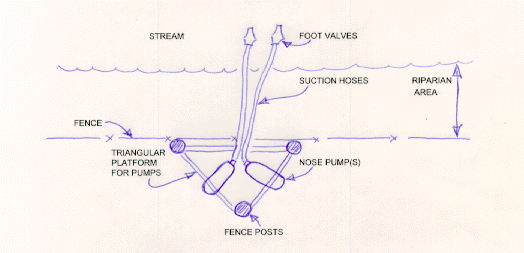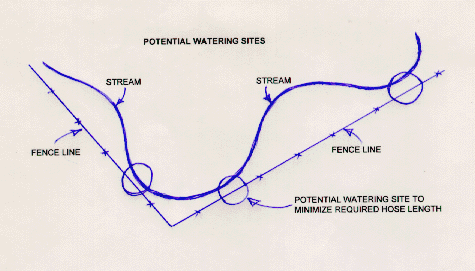![]()
![]()
Aquamat Pump & Platform Location - Fence Design
Considerations
To operate properly, nose pumps must be installed on a level surface.
We recommend that you install nose pumps in the
fence line on a sturdy, raised platform. The platform should be designed
to prevent livestock from stepping on, climbing over, or defecating into
the nose pumps. The triangular pump platform shown in the photo of the
bull drinking is an optimal design for installing one or two pumps. It
is structurally strong, resists cows rubbing and pushing, and requires
the minimum amount of lumber to build. If two pumps are installed on the
platform, the triangular design splits off a "boss" cow and prevents
one animal from dominating the watering station. A blueprint and materials/
cutting list for constructing the triangular pump platform is included
in the owner's manual sent out with each pump.

NOTE: THE PLATFORM
SHOULD BE PLACED AS CLOSE TO THE FENCE AS POSSIBLE, TO PREVENT SMALL CALVES
FROM BECOMING TRAPPED BETWEEN THE FENCE WIRES AND THE PLATFORM. IF DESIRED,
TWO OF THE PLATFORM FENCE POSTS CAN BE USED DIRECTLY IN THE FENCE LINE.
To minimize hose length and thus, the required
pump pushing effort, fences should be laid out so that the pump platform
can be installed as close as is practical to the water source. If a wider
riparian setback of, say 100 feet, is to be used, the fence would ideally
be designed so that in just one place, it comes to within 20 feet from
the stream, and the pump platform installed there. The shorter the hose,
and the less the lift, the gentler the pump pushes. This is especially
important to observe for horse and calf applications where the easiest
possible pump action is desired.

From the AQUAMAT OWNER'S MANUAL:
1. All pastures with total livestock exclusion from streams should have
a pump platform.
2. If the suction hose must be either long or run in a difficult place,
plan to leave the hose in place with the platform when the pump is moved
with the cattle to another pasture. Specify quick disconnects. Allow one
male end for each hose, and one female coupler for each pump.
When quick disconnects are to be used on two pumps mounted on the same
platform, either the boards that the pumps are mounted on must be extended,
or a 90 degree street elbow must be used on one pump to avoid interference
between the quick disconnects.
3. Pump performance is based on lift and run, that is, on the total combined
vertical and horizontal distance of the pump from the water source. The
greater the total distance, the harder the pump action. Try to locate the
pump as close to the water source as possible, and take this into consideration
when laying out the fence.
4. Structurally the triangular design of the platform works the best in
fence line applications. It is an optimal design for all types of fences
and for either one or two pump installations. No significant savings in
materials can be realized for single pump installations by using a different
design.
5. The pump can be damaged if it is allowed to freeze and an animal attempts
to use it. During freezing weather the pump should be drained and stored
away from your livestock.
![]()
RIPARIAN RESTORATION
![]() PUMP
OPERATION
PUMP
OPERATION ![]() PUMP
APPLICATIONS
PUMP
APPLICATIONS
COST EFFECTIVE ![]() FEATURES
& PERFORMANCE
FEATURES
& PERFORMANCE ![]() PUMP
LOCATION
PUMP
LOCATION
![]()
BLUE SKIES WEST![]() 110
MICHIGAN HILL RD.
110
MICHIGAN HILL RD.
CENTRALIA, WA 98531-9405
1.888.NOSEPUMP![]() FAX: 360.736.6812
FAX: 360.736.6812
E-MAIL:BSW@REACHONE.COM